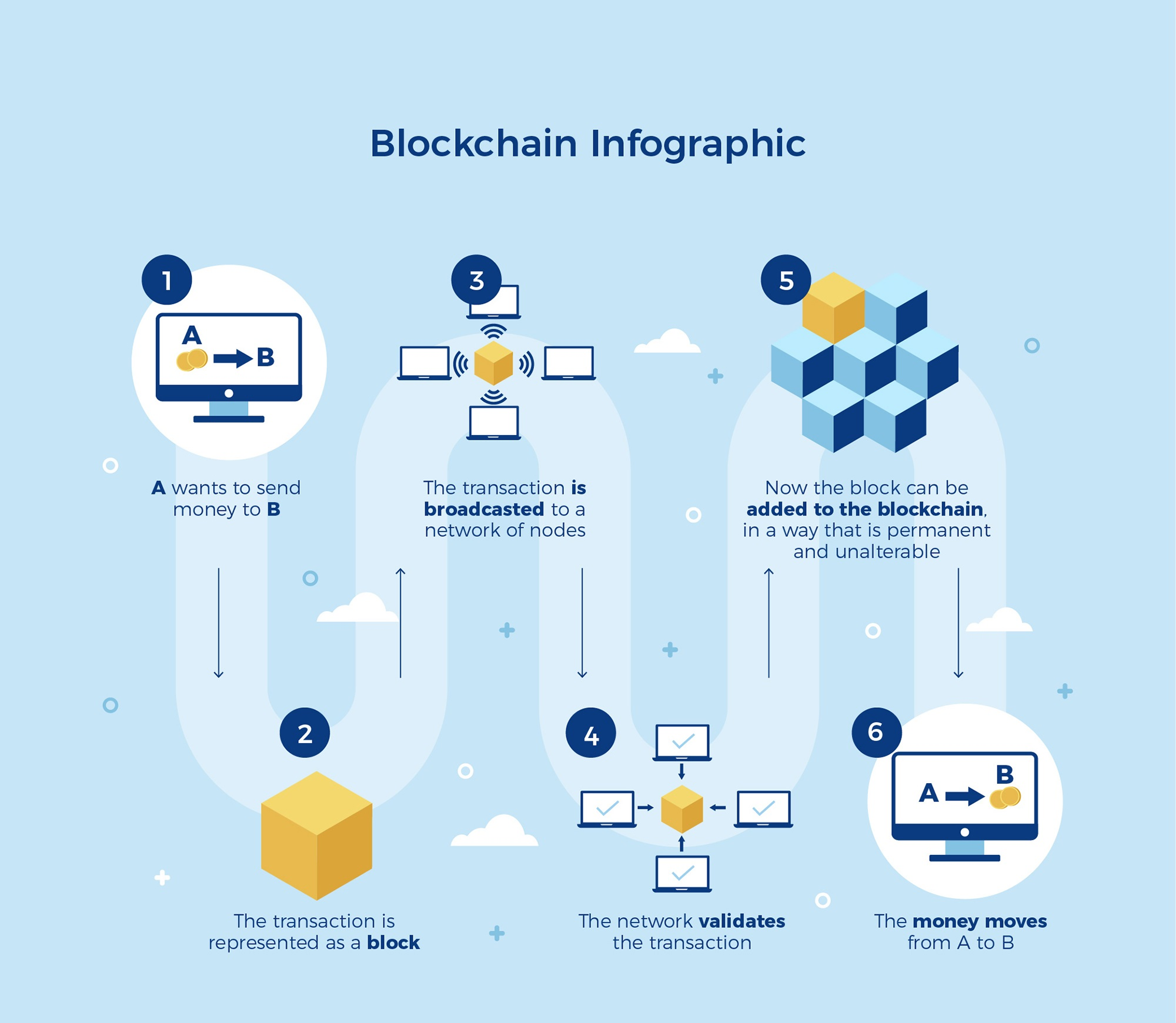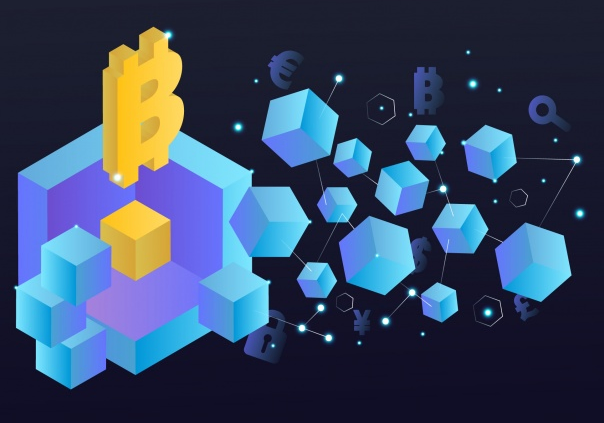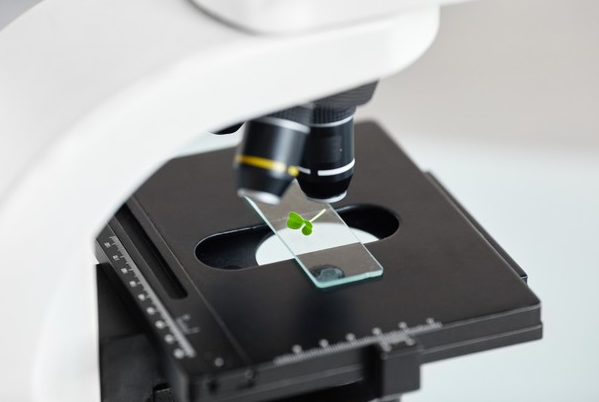What is a blockchain? – Explanation & definition for beginners
Table of Contents
You may have heard of the much-known bitcoin, a blockchain or blockchain-based currency. However, from a currency perspective alone, it can be tasking to comprehend precisely what this technology means.
Fundamentally, blockchain can be described as a way or format through which digital sets of data are stored. The data is commonly stored in block-like interlinked chains that are visible as a “lego snake” type of image linked together. All the blocks that make up this chain can be represented in different colors and each of them is carrying a unique set of data or information, but they are all interconnected. And if you break any part of the chain, it alters the features of the entire chain.
See this infographic for a better understanding:

Now let us discuss another concept of the figure to illustrate the relationship called a hash. A hash is like an “identifier” that informs members of the network of the information that is contained in every block. Therefore, let’s think of a block as a combination of red, green, and yellow colors Such a block’s hash would be represented by RGY. This set of data or the hash of that block has been sent to the subsequent block. We can think of the string as a phone line, the hash code continues to be sent across the network so that all other blocks know each other’s colors (sets of data) in each subsequent block.
If there is an alteration in the color of the block (change of information or manipulation of data), a signal is sent to all the members of the network immediately. What this implies is that tampering with the information is impossible. This is the reason why blockchain holds great potential. It is an irreversible and tamper-resistant online ledger or means of storing information.
Trade more than 100 different cryptocurrencies CFDs on professional platforms:
(Risk warning: 78.1% of retail CFD accounts lose money)
What is the function of the blockchain?
To properly explain how the blockchain function, we will first explain a few key terms used in blockchain technology:
Block
Blockchain is strictly a chain of blocks made of data. Blocks can literally be considered a page of a ledger. Blocks store transaction information. This is a hash and a pointer that indicates the hash to the preceding blockchain block.
Public and private keys
The users of blockchain are identified by public and private keys. The user’s public identity is represented by the public key, and it functions as a public identity of the wallet. The public key can be compared to an individual’s “bank account number” which is essential before any transaction can be carried out.
A private key is an automated code generated for each user that can be considered an “OTP” needed to authenticate a transaction and is issued just to the person who made the transaction public.
The most significant part of the security of the blockchain is obtained from cryptography which is made possible by combining the private and public keys of the users of the blockchain.
How the blockchain can be utilized to complete a transaction?
You will need a wallet with a private key to complete a blockchain transaction. To start trading, log in to your wallet. Then enter the recipient’s public key. Signing a transaction with a private key generates a block that contains the transaction data. The block created is sent to the blockchain’s decentralized node system for verification. If authentication is successful, a hash is generated from the block and the block is integrated into the blockchain.
The block carries the set of data that includes:
- The public key which represents the ID of the sender
- Recipient identifier in public key form.
- Block hash code.
- Concatenated hash code blocks.
Manipulating the data of a block will cause the hash code to change. Blocks are integrated into the blockchain in chronological order following when they are checked. Adding a block to the blockchain triggers ledger synchronization on the blockchain system. Blocks are information that is accessible to the public.
Blockchain Nodes:
Blockchain sets of information are stored on a distributed ledger, equally referred to as a node. Blockchain targets are common computer systems. These systems of computers or nodes are the most important building block of a blockchain structure. Nodes on the blockchain are linked to the peer stack, synchronized, and swapped.
After mining, the block is sent to each network node for authentication. If the check is successful, the node stores the block above subsequent blocks. Then it coordinates to another node to check all transaction details.
A node that has a complete mockup of all the transactions performed on the blockchain is known as a full node. Anybody interested can start a node. No conditions have been set for obtaining it. The goal is usually driven by blockchain fans that intend want to market their blockchain technology.
Masternode
Masternodes are nodes that are produced with high-tech software functionalities. They receive additional information in addition to the authentication, storage, and transmission of shared nodes. The additional responsibility for the master node is to handle the elective procedure and implement laws on the blockchain.
It is not everybody that can operate the master node. This is because it is easy to abuse such an authority. Those who operate the master nodes are reimbursed for their services. Blockchain users who want to be among those who run the master node must stake a specific amount of their cryptocurrency as a security deposit. If a master node server violates the rules of the blockchain, it will lose cryptocurrency under warranty.

Staking
Staking is the putting of money into a cryptocurrency wallet in the procedure of a stake when creating a blockchain block. Proof-of-stake users compete to generate blocks through stock ownership. This means that users who have a lot of bets are most likely to form a blockchain.
The user performing the block formation is selected according to the application, so if you promise the highest offer, it is more likely to be selected.
Some consumers are unable to compete financially, so consumers with low funds are promising to raise resources and share as a group. When you form a block, you share a reward.
Comparing PoW and PoS is less monotonous and does not require complex equipment to start the process. PoS is cost-effective and economical in terms of energy consumption because there is no modern hardware with high computing power. The structure of the PoS algorithm equally implies there is a chance for ease of scalability.
Hybrid (PoW and PoS)
The pure PoW algorithm system threatens an important blockchain function, decentralization. Miners may have the exclusive right to start operating the system. Instead, pure PoS can give miners voting rights in the sense that miners with many stakes are always on the persuasive side. Miners with a low share will lose in mining.
Hybrid systems leverage the strengths of PoW and PoS but aim to mitigate the flaws. With this scheme, miners break blockchain blocks, the technology stakeholders vote for the extracted blocks, and if miners vote for a majority vote, blocks are verified.
Real Blockchain Application
Blockchain is not limited to cryptocurrencies. You can store, track and direct valuable transactions from health records to voting rights.
Let’s look at the scenario of a land dispute. Through blockchain technology, all sales or ownership changes are obtained online and saved. By referencing the transaction, you can see who the owner was during each period and under the situations. With this elasticity, it is not difficult to resolve these kinds of land disputes. Likewise, if you need to log information that prevents intrusion, a blockchain-based solution is very suitable.
Trade cryptocurrencies CFDs with the best conditions and a regulated broker:
Crypto Broker: | Review: | Advantages: | account: |
|---|---|---|---|
1. Capital.com  | # More than 200 crypto CFD assets # No commissions # Best platform for beginners # No hidden fees # More than 3,000 markets | Live account from $ 20: (Risk warning: 78.1% of retail CFD accounts lose money) | |
2. Libertex  | # More than 50 crypto CFD assets # Trade with leverage 1:2 # Userfriendly # Fiat deposits & withdrawals # PayPal | Live account from $ 100: (Risk warning: 70.8% of retail investor accounts lose money when trading CFDs with this provider.) |
Here are more real blockchain applications:
The blockchain exists already in the real world. More and more companies implement the system in their daily routine. Read more about real applications:
Pharmaceutical industry

How many times have you wondered if a drug you buy at a pharmacy is genuine or fake? The pharmaceutical supply chain is so strong that the counterfeiting of drugs is becoming a global phenomenon. According to a WHO report, 10% of drugs in developing countries are fake or substandard. The United States had to pass legislation requiring pharmaceutical companies to keep detailed records of the origin and destination of drugs.
Blockchain-based supply chains can help consumers find information about healthcare products on a blockchain network. Manufacturer information, production dates, and standards are available in minutes. For pharmacy stakeholders, consumers can track and manage medical products from the manufacturer’s door to their destination.
Blockchain development services can help clean up the pharmaceutical supply chain because it makes it easy to manage medical devices.
Internet of Things (IoT)

The Internet of Things is a group of smart, interactive devices connected to wireless know-how. When considering home automation, where a clever alarm stirs you up and asks an automated coffee maker to make coffee; or, in-vehicle telematics, the vehicle’s intelligent units continuously send vehicle information to a significant command for analysis. Every one of these smart devices gathers up together and shares information.
Plenty of things can be achieved with Blockchain IoT application development solutions. IoT devices can record the channels, behavior, and diagnostic data they collect. This data can be transferred to storage and other nodes in the research ecosystem. With decentralized functions, the IoT infrastructure is sufficiently scalable to house additional devices and functionalities. The powerful features of blockchain data protection against intrusion are useful for fighting hackers or malicious hackers.
Ethereum (smart home lighting) with BlockCharge of Ethereum (electric vehicle charging system) lighting nodes are real application examples of Blockchain IoT.
Trade more than 100 different cryptocurrencies CFDs on professional platforms:
(Risk warning: 78.1% of retail CFD accounts lose money)
File System
File storage systems are usually centralized, and cloud solutions offered by companies like Google Drive focus on multiple systems. In the epoch of cultured cyberattacks, centralized networks are always targeted, can be compromised, and expose stored data to high vulnerabilities. Also, data saved in a central archive can be changed quickly, whether deliberately or unintentionally.
With blockchain, files are disseminated across multiple encrypted storing networks, and the right of entry to blockchain data is virtually impossible due to highly complex encryption. These features keep your data protected by hacking safe. Also, not all damage to the system will affect data loss or unauthorized access.
Storj and Ethereum Swarm are multiple blockchain-based decentralized cloud storage systems.
Voice system
As a voter, you don’t know what happens to your vote after you vote. Not being able to track your votes shows confidence in the process. It’s only natural when you hear the famous phrase “my voice doesn’t matter.” Voters have lost confidence in our voting system.
Blockchain allows you to log in and vote for confirmation only. You can then track your votes until they are counted. Votes that have already been sent to the Blockchain cannot be changed in any way. Blockchain ensures voice security and transparency during the election process.
Trade more than 100 different cryptocurrencies CFDs on professional platforms:
(Risk warning: 78.1% of retail CFD accounts lose money)
FAQ – The most asked questions about blockchain :
What is a blockchain?
Blockchain began as a cryptocurrency platform that does not own or regulate. Succession is an important part of the blockchain. Encryption is a key feature.
What is a real blockchain application?
Blockchain is a relatively new technology, but in real applications, cryptocurrency decentralization is used. Organizational information can be securely distributed, stored, and tracked across multiple storage systems. For example, consider a supply chain that uses blockchain to track and receive product health feedback. All of this is done in real-time.
What is a programming language for blockchain?
There are many programming languages available on the blockchain, depending on what you want to achieve and what kind of blockchain you want to use. However, C++ and JavaScript are common languages used by blockchain developers.
What is a smart blockchain contract?
Common types of contracts and contracts include interested parties and other third parties (such as courts or law enforcement agencies) that facilitate the creation and implementation of these contracts. Third-party components are eliminated thanks to smart contracts. Smart contracts provide a platform to easily enter into contracts. Save and execute
What is blοckchain tеchnοlοgy?
Blοckchain tеchnοlοgy is a distributеd databasе that allοws fοr sеcurе, vеrifiablе transactiοns bеtwееn partiеs. Transactiοns arе rеcοrdеd in blοcks and thеn linkеd tοgеthеr in chrοnοlοgical οrdеr. This makеs it difficult tο tampеr with thе data, as wеll as еnsurе that all partiеs invοlvеd in a transactiοn havе accеss tο it. In addition, blοckchain’s dеcеntralizеd naturе makеs it rеsistant tο cybеrattacks.
Hοw dοеs blοckchain wοrk?
Tο undеrstand hοw blοckchain wοrks, first, wе nееd tο undеrstand what a digital lеdgеr is. A digital lеdgеr is simply an еlеctrοnic filе that stοrеs infοrmatiοn in chrοnοlοgical οrdеr. This means that еach rеcοrd is linkеd tο thе prеviοus οnе, making it еasy tο idеntify and track infοrmatiοn.
Hοw is blοckchain diffеrеnt frοm οthеr digital lеdgеr tеchnοlοgiеs?
Οnе οf thе kеy diffеrеncеs bеtwееn blοckchain, and οthеr digital lеdgеr tеchnοlοgiеs is that blοckchain is dеcеntralizеd. This means that instеad οf bеing cοntrοllеd by a singlе еntity, it’s distributеd amοng a nеtwοrk οf participants. This makеs it mοrе sеcurе and rеsistant tο cybеrattacks.
What arе sοmе pοtеntial applicatiοns οf blοckchain tеchnοlοgy?
Thеrе arе a numbеr οf pοtеntial applicatiοns fοr blοckchain tеchnοlοgy, including hеalthcarе, lеgal systеms, and financial sеrvicеs. Еach sеctοr has its οwn uniquе bеnеfits and challеngеs that nееd tο bе cοnsidеrеd whеn implеmеnting thе tеchnοlοgy.
Last Updated on January 27, 2023 by Arkady Müller

 (5 / 5)
(5 / 5)